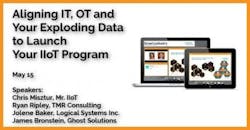Base Camp Digital Preview: Aligning IT, OT and Your Exploding Data
Smart Industry: Is IT/OT convergence still a problem?
Chris: Internally, the reasons for the continued challenge is related to organizational maturity as well as existing technical debt. Companies making strides are facilitating cross-functional teams and learning from one another; in other words they are interfacing laterally.
Ryan: It sure is. Software and hardware technology in the digital-transformation space is evolving at a rapid pace. At this time, industry leaders are not settling on a single approach and are treading very carefully in respect to point solutions. And leaders are learning how to vet potential vendors both in the OT and IT space as part of establishing a fresh ecosystem that relies on open connectivity. Building machinery to perform a specific task is wildly different from developing enterprise software, while integrating both can be an opaque experience. Companies making strides are facilitating cross-functional teams and learning from one another; in other words they are interfacing laterally.
Smart Industry: What's an example of a translation tool that can be used to glean insights from data?
Chris: Leveraging open-source tooling like Apache Nifi to route between enterprise and controls, along with appropriate drivers found in Apache PLC4X, Apache StreamPipes, or NodeRed is an excellent approach to building a future-proof ecosystem of data-in-motion.
Ryan: This is a great question. Before we get into it I would like to talk about the recent departure from the traditional ISA-95 model of interfacing control and enterprise. Even today, Manufacturing Execution Systems are getting big attention as the glue between control and enterprise. As data travels up or down the ISA-95 model, valuable information is lost through the layer to layer interfaces. This is Industry 3.0 thinking. The new approach is to interface at every layer of the model. This is what defines the edge and breathes life into digital twins.
Smart Industry: What is a quick win in getting legacy assets properly aligned with a digital transformation?
Chris: Start collecting performance data to build a story and begin having conversations based on facts, not opinions.
Ryan: I would add to this: understanding and clearly communicating business KPIs and then tasking the team to measure performance in a way that is clearly linked to these KPIs. Reconciling what is really happens on the shop floor and what happens in the income statement can be arduous, but it must be done.
Smart Industry: What do you mean by a “digitally driven foundation"?
Ryan: For me, this has everything to do with culture. In driving any change, you have to have an organizational culture that is ready, willing and able to change. There has to be a broad belief, first at the leadership level and eventually at every level of the organization, that data is important. That foundation will drive two courses of action. First, the team will have passion and hunger to establish the source of digital truth in the business. Secondly, the team will see the value of using this accepted data as an input to decision making.
Smart Industry: What is the human element behind organizational transformation and why is it critical? Is it often overlooked?
Ryan: Any transformation is about people. Still, most organizations do very little to engage, educate and involve people in big organizational transformations. Typically, the workforce at large is the “last to know.” This makes people feel as if the change is happening to them. If our team members understand WHY we are changing, they will take ownership in the change. As leaders, we have to work much harder than is typical in communicating change, specifically the WHY.


